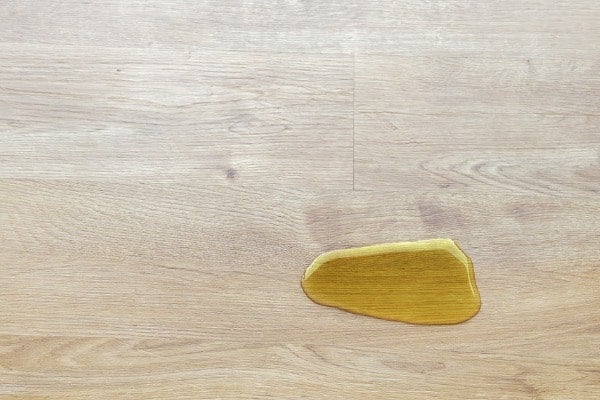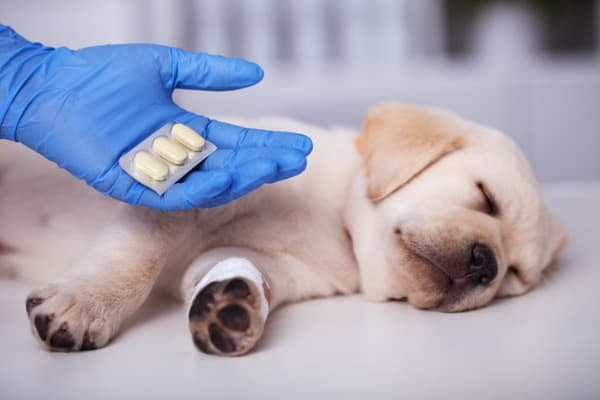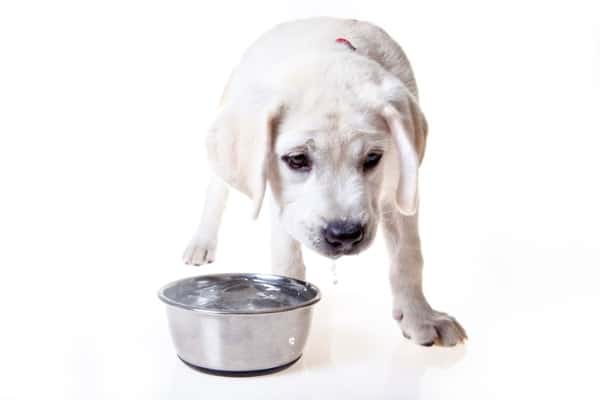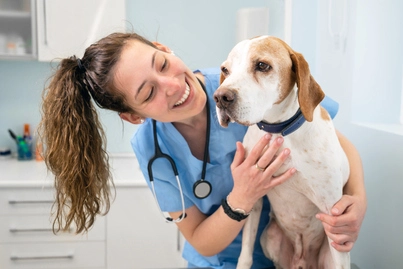Your dog just went to the bathroom, and you find something unusual – mucus in their urine.
Yikes, right?

The presence of mucus or pus in the urine is certainly strange and understandably alarming.
So what does it mean when you find pus in dog urine, and should you be concerned?
It can mean a few things, and although it’s no reason to panic, it is something to check out with your vet.
Most importantly, this condition isn’t something you want to ignore.
See also:
- Dog Peed on My Bed in Front of Me: Here’s What You Can Do
- Urine Scald in Dogs: 5 Best Treatments
- How Long Can a Dog Go without Peeing: 7 Healthy Answers
- Dog Drinking Own Urine: 5 Causes and How to Stop It
- Is Dog Urine Harmful to Humans: Answers You Should Know
What are the causes and other symptoms you should be aware of?
We’ll go over all that and more, so you can solve the mystery of why your dog’s pee isn’t healthy.
We’ll also talk about some of the things you can expect at the vet and how you can help your dog’s bathroom habits get back to normal.
Connect with a verified veterinarian in minutes. No waiting for appointments or office hours. No high fees. Your pet's health made convenient and worry-free.
Bacterial Cystitis

The basic definition of this condition is inflammation of the inside of the bladder.
The most common cause?
It’s bacteria that have taken up residence inside the bladder, causing infection and inflammation.
Sometimes the origin of the infection can be fungal rather than bacterial.
How and why does that happen?
The bladder is usually sterile, but bacteria can sometimes make their way up through the urethra.
In some scenarios, bacteria can descend from the kidneys, but this is usually not the case – and it usually accompanies other health issues with symptoms of their own.
Bacterial cystitis can also cause white blood cells in dog urine – a condition known as pyuria.
So if your vet performed a urinalysis on your dog and found white blood cells, the likely cause is an infection of the bladder or urinary tract.
Pyuria can also mean a tumor, the presence of a foreign body, or trauma.
If white blood cells are detected in your dog’s urine, your vet might advise other tests to rule out all causes.
Infection of the bladder can cause cloudy urine in dogs and traces of mucus or pus.
Other things to look out for if you suspect a bladder infection?
Blood in the urine, discomfort or crying while urinating, or licking the urethral opening can all signal an infection.
You also might notice your dog needs to go out more often but doesn’t seem to be peeing a lot despite acting like they’re about to have an accident.
The urine might have a foul, fishy smell – or your dog may smell of urine.
Accidents can happen, too, as your dog could be feeling an uncontrollable urge to urinate.
For example, you might notice urine leaking when your dog is lying down.
These infections could be in the bladder or in the urinary tract.
We’ll cover that next.
Any of these symptoms should be evaluated by a vet, as there is no guaranteed home remedy for bacterial cystitis.
Bladder stones can also cause inflammation and be a breeding ground for bacteria.
In either case, proper medical treatment is the best course of action.
Some bladder stones are small enough that medication will help them to dissolve or break up to the point they can be passed through urine.
Larger ones can require surgery to remove, but if this condition is caught early enough, there will be better options for getting rid of them.
UTIs In Dogs

The symptoms of bacterial cystitis can mimic those of a urinary tract infection.
The only difference?
In a UTI, the infection is still in the urinary tract. These infections can be a precursor to bladder infections, especially if they’re not caught soon enough.
A UTI can travel upwards to the bladder if they’re not treated, causing bacterial cystitis.
In the worst-case scenario, the infection can also move into the kidneys, where it becomes more challenging to treat.
While a UTI can cause mucus in the urine and many other symptoms that point to a full-blown bladder infection, it’s not always that serious.
What’s essential is that pet parents address these symptoms and seek treatment for their dogs right away.
The sooner the vet can diagnose and treat a UTI, the less chance the infection has to spread to the bladder.
Only a vet has the proper diagnostic tools to determine if the infection is limited to the urinary tract.
So, this is another issue you won’t want to treat at home.
Females in Heat
While dogs in estrus shouldn’t have mucus in their urine, they can sometimes excrete mucus from their vulva.
It can be difficult to tell if mucus in the urine actually came from the urine itself.
If your female dog is unspayed, and you know she is due to come into heat, what looks like pus in the urine could actually be a side-effect of her heat cycle.
A jelly-like substance in dog urine might not be from her bladder at all.
Look out for other symptoms of bladder or urinary tract infections.
A vet can help figure out if the mucus is from an infection or a regular part of estrus.
If your dog isn’t displaying any other signs of infection while in heat, the mucus which appears to be in the urine might not be anything to worry about.
Monitor your dog closely, and inform your vet of anything you’re concerned with including things like visible darker urine during potty breaks or the presence of foam in your dog’s urine puddle.
What’s the Prognosis?

The sooner you get your dog medications for an infection or bladder stones, the better.
The condition can worsen quickly, so a round of antibiotics is your best weapon against it.
In most cases of infection, antibiotics are all that’s needed to clear it up.
Some infections can be more resistant to antibiotics, and the commonly prescribed ones don’t always do the trick.
If your dog’s symptoms don’t show any improvement after a week of antibiotics, you should update your vet.
Sometimes, the vet will need to do a urine culture to determine if the bacteria present need a more potent antibiotic to defeat them.
In the case of bladder stones, a prescription diet of urinary care dog food or medication can be administered to break them down.
Once small enough to pass, your dog will flush them from their system through regular urination.
Your vet might also prescribe pain management medication through this process.
Lithotripsy is often used for larger stones.
Ultrasonic waves can break up the bladder stone, making it easier to remove via suction.
Your dog will either be sedated or anesthetized for this procedure. It’s simple and safe, with a short recovery time.
Sometimes, a tumor or other foreign body can be the cause of a bladder infection or inflammation.
In this scenario, your vet will discuss all options and make recommendations based on your dog’s health and age.
The bottom line?
Mucus in dog urine can indicate some scary conditions.
There are ways to treat them, and plenty of things can be done in the vet’s office and at home to get your dog healthy again.
How Can You Help Your Dog?
After you’ve made the trip to the vet to receive a diagnosis, you can do a few things to help your dog heal.
Vet’s Orders
First and foremost, following all vet’s orders is number one on your list.
If antibiotics are prescribed, give your dog the full course – even after your dog’s symptoms disappear.
You might have been sent home with pain meds or probiotics, too.
Make sure you feed these to your dog; the pain pills will help make them comfortable as they battle the infection.
Probiotics will encourage the growth of good bacteria, which will fight against the bad bacteria that caused the infection in the first place.
The antibiotics might wipe out a lot of good bacteria, so probiotics also help repopulate good bacterial colonies.
Hydrate Your Pup

Clearing up a bladder or urinary tract infection includes a healthy amount of water intake.
The more your dog drinks, the more they will urinate.
If they get plenty of water, get them out for potty breaks. Don’t let them refuse to go outside to pee if they aren’t feeling well.
The more they urinate, the more bad stuff they will flush out of their system.
There’s more:
Infections or crystals in dog urine have a better chance of hanging on or compounding if your dog doesn’t pee enough.
Even if they’re getting antibiotics, flushing out unwanted bacteria is very helpful.
If your dog is reluctant to drink more, there are ways you can sneak more liquid into their routine.
Feeding wet food or soaking their kibble in water or broth is an easy way to hydrate them further.
Make sure any broth is low-sodium or sodium-free – excess salt can worsen things.
DIY ice treats are another way to encourage them to up their water intake.
A freezer, a popsicle mold or ice tray, some broth, and enticing treats are all you need.
You can freeze tasty tidbits like cooked chicken or small bacon pieces in broth or plain water.
Once it’s solid, you can let your dog go to town on their “dogsicle.”
As always, make fresh water available at all times. Dogs seem to enjoy “gross” things, but their water bowl is something you should keep clean.
They might avoid drinking if their water has too much slobber, debris, or grime.
Mucus in Urine is “Snot” Pretty

If you’ve dealt with this issue with your dog, you know it’s no fun to deal with.
It probably accompanies other “yucky” symptoms like stinky, bloody urine or nasty accidents on the carpet where you have to remove urine odors.
We know that your dog is also your furry baby, and helping them through this messy problem is part of being a pet parent.
When dog urine is a milky color, contains pus, and comes along with overall discomfort for your dog, a trip to the vet is the first step in resolving the problem.
Once medication and treatments have been prescribed, the symptoms should disappear quickly. Get ready to administer some TLC at home in the meantime.
Any pet parent who has seen their dog through these issues knows: sometimes, a typical puddle of pee is worth cheering about.

